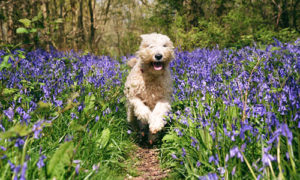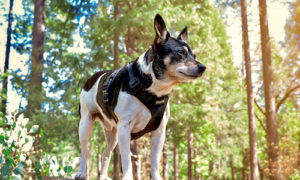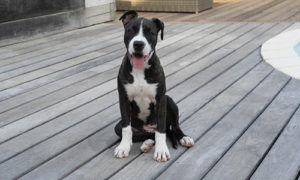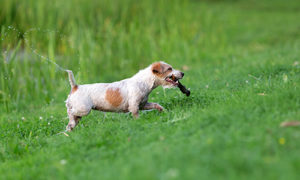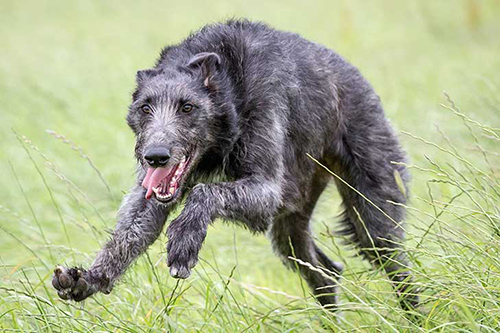
Scottish Deerhounds are an ancient breed of Scotland considered a close relative of the Irish Wolfhound, which was also developed from Ancient Celtic sighthounds to course big game. Ownership of these dogs was restricted to nobility for centuries. Economic, social, and environmental changes pushed the breed to the brink of extinction by the 19th century. Eventually, it gained a new following during the Victorian era thanks to Sir Edwin Landseer’s paintings, Walter Scott’s writings, and Queen Victoria’s patronage.
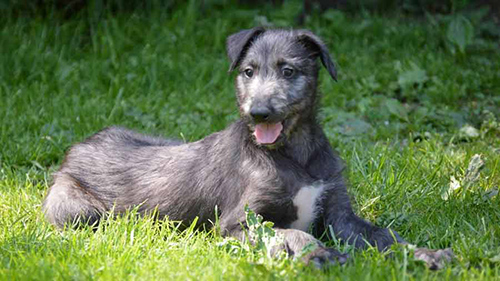
Breed Standard
The Scottish Deerhound is a rough-coated, large sighthound with a long neck covered with a mane, a deep chest, and a flexible back. The legs are long, sturdy, straight, and the toes are well arranged. The long tail is curved but never carried higher than back level. This dog possesses a long, flat skull and a pointed muzzle with a silky beard and mustache. The ears are set high, covered with black or dark hair, folded back, or held semi-erect when alert. The dark eyes give the breed its characteristic soft expression.
Deerhounds have a body like a Greyhound but are larger in size and bone, allowing them to run at great speed using the double-suspension gallop without forfeiting strength and stamina. The dog’s trotting gait is proper and easy.
Breed Facts
| Energy level | Watchdog ability | ||
| Exercise requirements | Protection ability | ||
| Playfulness | Grooming requirements | ||
| Affection level | Cold tolerance | ||
| Friendliness toward dogs | Heat tolerance | ||
| Friendliness toward other pets | Friendliness toward strangers | ||
| Ease of training |
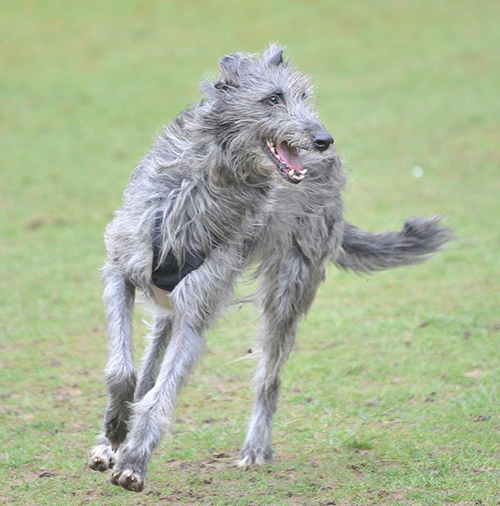
Activity level: Moderate. With their long legs, Scottish Deerhounds require sufficient exercise in a safely fenced, reasonably large area. Puppies are busy and need to be watched when exercising. Although this breed is substantially suited for outdoor living in cool or temperate climates, it prefers to live inside with its family and requires plenty of human bonding. Nevertheless, it requires soft bedding to prevent callouses.
Grooming: These dogs do well with weekly brushing using a slicker brush in the direction the hair grows. Use a steel comb for longer hair. Only bathe as needed, which will help remove the doggy odor but soften the coat’s naturally harsh texture. The crisp coat requires combing 1 or 2 times weekly. Some scissoring is elective to tidy up straggling hair, plus slight stripping around the face and ears.
Coat: The dog’s coat is crisp and somewhat wiry, 3 to 4 inches long, with a small tassel on the inside of the forelegs and the hind legs.
Color: Dark blue-gray, shades of gray or brindle, yellow, sandy red, or red fawn.
Group: Hound
Year of recognition by the AKC: 1886
- Popularity: Very rare
- Family group: Sighthound
- Country of Origin: Scotland
- Original purpose: Coursing stag
- Today’s purpose: Lure coursing
- Other names: Deerhound
Scottish Deerhound Temperament
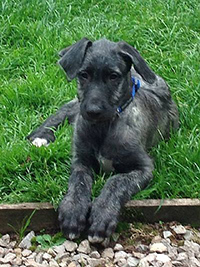
The Scottish Deerhound was developed as a courageous, hardy coursing dog known for its excellent manners. They are devoted, loyal, and eager to please. These dogs require plenty of human companionship, and are delightfully quiet, mature, and dignified house dogs. Scottish Deerhound puppies are curious, energetic, and require the usual amount of supervision. They get along nicely with other dogs, but true to their nature; they will pursue small animals. Begin training at a young age, and focus on getting the pup’s attention and influencing appropriate responses.
Thanks to its low-key, easygoing, and mellow personality, the Scottish Deerhound is a gracious and well-mannered addition to any home. When outdoors, the dog will chase anything that moves. However, it requires plenty of room to stretch on a soft surface indoors. It is willing to please but also independent and sensitive. It is friendly toward but often reserved with strangers. The dogs are good with children, other dogs, and usually other pets, though they chase strange animals.
Health
- Main concerns: gastric torsion, cardiomyopathy, osteosarcoma
- Minor problems: cystinuria, atopy (allergies)
- Rarely seen: hypothyroidism, neck pain, factor VII deficiency
- Recommended tests: cardiac, (cystinuria), factor VII
- Life span: 7 to 9 years
- Weight: male – 86 to 111 pounds; female – 76 to 96 pounds
- Height: male – 30 to 32 inches (average 32 inches); female – at least 28 inches (average 30 inches)
Breeder and Buyer’s Advice
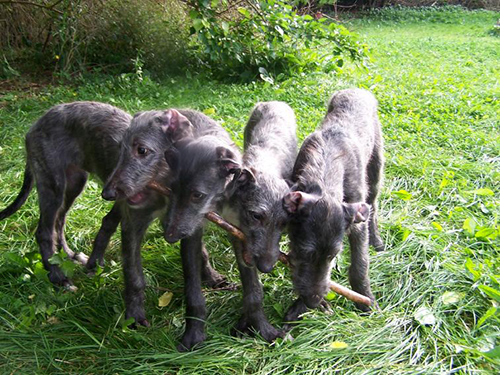
Before bringing a puppy home, the hours of research you put in will be well worth the effort. Do not shy away from asking breeders plenty of questions. Find out whether or not the breeder does health testing, participates in dog sports, such as showing, coursing, or obedience, and belongs to the national club. Visit the parent club’s website for a listing of trusted breeders in your area and to get information on puppies for sale and their asking price.
Parent club: Scottish Deerhound Club of America (https://deerhound.org/); founded in 1906
Rescue: SDCA Rescue and Placement Committee information can be found on the club’s website.

